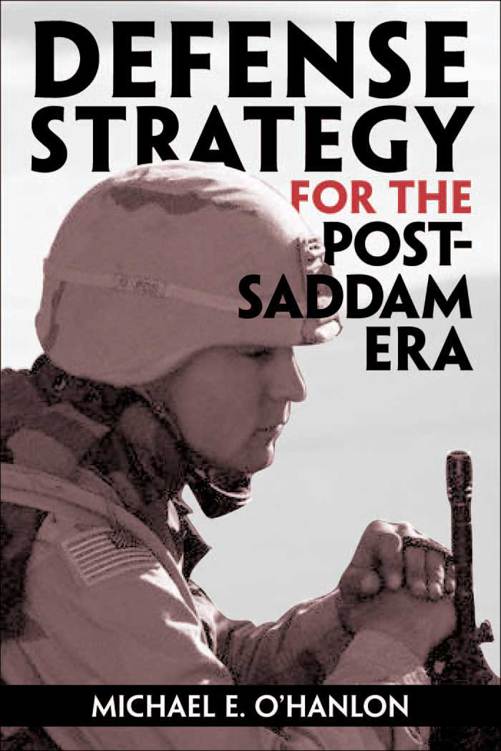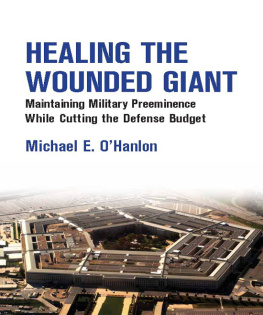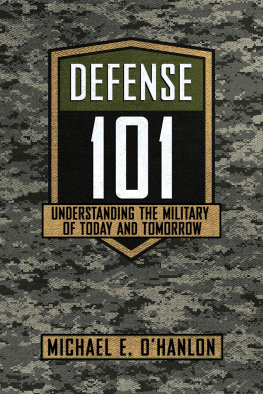OHanlon - Defense Strategy for the Post-Saddam Era
Here you can read online OHanlon - Defense Strategy for the Post-Saddam Era full text of the book (entire story) in english for free. Download pdf and epub, get meaning, cover and reviews about this ebook. year: 2005, publisher: Brookings Institution Press, genre: Politics. Description of the work, (preface) as well as reviews are available. Best literature library LitArk.com created for fans of good reading and offers a wide selection of genres:
Romance novel
Science fiction
Adventure
Detective
Science
History
Home and family
Prose
Art
Politics
Computer
Non-fiction
Religion
Business
Children
Humor
Choose a favorite category and find really read worthwhile books. Enjoy immersion in the world of imagination, feel the emotions of the characters or learn something new for yourself, make an fascinating discovery.
Defense Strategy for the Post-Saddam Era: summary, description and annotation
We offer to read an annotation, description, summary or preface (depends on what the author of the book "Defense Strategy for the Post-Saddam Era" wrote himself). If you haven't found the necessary information about the book — write in the comments, we will try to find it.
OHanlon: author's other books
Who wrote Defense Strategy for the Post-Saddam Era? Find out the surname, the name of the author of the book and a list of all author's works by series.
Defense Strategy for the Post-Saddam Era — read online for free the complete book (whole text) full work
Below is the text of the book, divided by pages. System saving the place of the last page read, allows you to conveniently read the book "Defense Strategy for the Post-Saddam Era" online for free, without having to search again every time where you left off. Put a bookmark, and you can go to the page where you finished reading at any time.
Font size:
Interval:
Bookmark:

This page intentionally left blank
Washington, D.C.
Copyright 2005
THE BROOKINGS INSTITUTION
1775 Massachusetts Avenue, N.W., Washington, D.C. 20036 www.brookings.edu
All rights reserved. No part of this publication may be reproduced or transmitted in any form or by any means without written permission from the Brookings Institution Press.
Library of Congress Cataloging-in-Publication data
O'Hanlon, Michael E . Defense strategy for the post-Saddam era / Michael E. O'Hanlon .
p. cm. Summary: Offers pragmatic policy recommendations for strengthening the
U.S. military's ability to respond to international crises, with engagement or deterrence, and protect American citizens while maintaining fiscal responsibil ity, by expanding ground forces yet containing spending, modernizing weaponry, implementing privatization and reform, and encouraging burden sharing with alliesProvided by publisher.
Includes bibliographical references and index . ISBN-13: 978-0-8157-6467-0 (pbk. : alk. paper ) ISBN-10: 0-8157-6467-
United StatesMilitary policy. 2. United StatesArmed Forces. 3. Afghan War, 20014. Iraq War, 2003. 5. World politics21st century. I. Title.
UA23.O34 2005 355'.033573dc22 2005001645 9 8 7 6 5 4 3 2 1
The paper used in this publication meets minimum requirements of th e American National Standard for Information SciencesPermanence of Pape r for Printed Library Materials: ANSI Z39.48-1992 .
Typeset in Sabon and Myria d
Composition by OS P Arlington, Virgini a
Printed by R. R. Donnelle y Harrisonburg, Virgini a
To the brave men and women of the U.S. armed forces
This page intentionally left blank
Foreword ix
CHAPTER ONE
Introduction
CHAPTER TWO
Setting the Context: The Afghanistan and Iraq Wars and Their Lessons
CHAPTER THREE
The Need to Increase the Size of U.S. Ground Forces
CHAPTER FOUR
The Draft, the Overseas Base Structure, and the Allies
CHAPTER FIVE
Modernizing Weaponry
CHAPTER SIX
Beyond Iraq and North Korea
Notes
Index
vii
This page intentionally left blank
T his short but timely book by Mike OHanlon follows Brookingss long-standing commitment to in-depth analysis of the fed eral budget and, in the case of Mike and his predecessors in the Foreign Policy Studies program, to the subject of U.S. military strategy and the defense budget.
Defense Strategy for the Post-Saddam Era is Mikes fourth such study in his ten-year tenure at Brookings and continues a series of analyses that have been written by Barry Blechman, William Kaufmann, Martin Binkin, Lawrence Korb, Joshua Epstein, and others. Mike examines broad questions such as Americas two-war planning framework, the mil itary requirements imposed by maintaining alliances or other close secu rity relationships with some seventy countries, and the implications of Bush administration preemption doctrine for the U.S. armed forces. He also distills the lessons of the recent Afghanistan and Iraq campaigns for American defense planning.
The book looks in detail at the question of the appropriate size of U.S. ground forces. After agreeing with the administrations basic two-war logic, Mike reaches a different conclusion about how large the Army and Marine Corps should be. Arguing that the extraordinary demands of the Iraq operation are imposing huge burdens on the active and reserve forces of the Army and Marine Corps in particular, he favors adding at least an
ix
FOREWORD
additional 40,000 ground troops to the active duty ranks of the U.S. mil itary for the foreseeable future.
Mike focuses intently on the Iraq operation and its implications for current planning, but also assesses other contemporary issues such as the Pentagons plan to revamp its overseas base structure, the possibility that
U.S. allies might be able to pick up more of the global military burden in the years ahead, and the question of the military draft. He suggests how the Pentagon might further reduce the costs of its planned acquisition programs, cutting anticipated expenditures on large weapons platforms by making the more economical improvements that can often result from modernizing sensors, computers, communications systems, robotics, and munitions. In an effort to begin discussion of long-term policy and capa bilities, Mike looks beyond the immediate operations in Iraq and Afghanistan to analyze scenarios ranging from naval conflicts in the Taiwan Strait and the Persian Gulf to war on the Korean peninsula to large-scale multilateral stabilization missions in South and Southeast Asia.
Mike thanks his research assistant, Adriana Lins de Albuquerque, as well as several anonymous external reviewers, for their help with the manuscript.
Strobe Talbott
President February 2005 Washington, D.C.
W hat kind of military will the United States need in the future, and how much will it cost? In an era of apocalyptic terrorist threats and other dangers there is little doubt that the country must do what it takes to protect itself. That said, at a time of $400 billion federal budget deficits, the country must also spend wisely.
This book argues that the Bush administrations planned defense budget increase of some $20 billion a year into the foreseeable future is indeed necessary. Half of that increase accounts for inflation, roughly speaking, and the rest represents real growth in the defense budget. But in contrast to current plans, a central argument of this book is that the administration should temporarily increase the size of the countrys ground forces by at least 40,000 active duty troops. This is necessary in order to treat soldiers and Marines more fairly by reducing at least mod estly the frequency and length of deployments and to ensure that the extraordinarily high pace of overseas operations does not drive people out of the military, thereby putting the health of the all-volunteer armed forces at risk.
Given the fiscal pressures, at the same time that it carries out this tem porary increase in personnel the U.S. military must look harder than ever for ways to economize and improve efficiency in other areas of defense.
INTRODUCTION
The need is most notable in its weapons modernization programs. Fortu nately, the promise of high technology, especially with regard to electron ics and computers, allows the United States to continue to innovate and improve its armed forces somewhat more economically than in the past. Once the current mission in Iraq ends or declines significantly in scope,
U.S. ground forces can be scaled back to their present size or perhaps even a slightly smaller number, and it may become possible to hold real defense spending steady for a number of years. But not yet. And while a drastic reduction in U.S. forces in Iraq is possible starting in 2006 or 2007, planners cannot presume that it will occur. Indeed, in January 2005, a senior Army planner publicly acknowledged that the military is making plans to sustain troop strength in Iraq at current levels through 2006.
The Strategic Backdrop
U.S. armed forces will likely remain engaged in Iraq and Afghanistan for the foreseeable future. They will also need to remain involved in deter rence missions in the Western Pacific, most notably in regard to the Korean Peninsula and the Taiwan Strait. The United States will wish to remain strongly engaged in European security as well, less because of threats to the region than because most of Americas main security part ners are located there. The strength, capabilities, and cohesion of the members of the NATO alliance therefore have important global implica tions for the United States.
Font size:
Interval:
Bookmark:
Similar books «Defense Strategy for the Post-Saddam Era»
Look at similar books to Defense Strategy for the Post-Saddam Era. We have selected literature similar in name and meaning in the hope of providing readers with more options to find new, interesting, not yet read works.
Discussion, reviews of the book Defense Strategy for the Post-Saddam Era and just readers' own opinions. Leave your comments, write what you think about the work, its meaning or the main characters. Specify what exactly you liked and what you didn't like, and why you think so.












